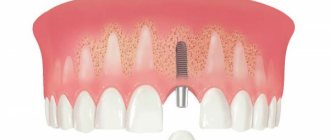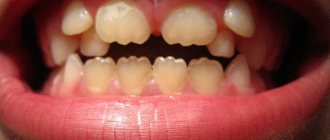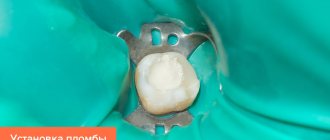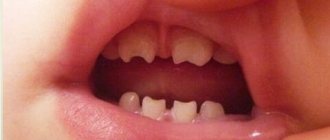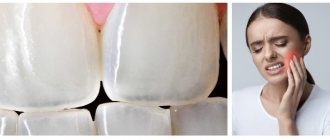A beautiful smile is a natural desire of people, regardless of age and gender. In pursuit of aesthetics, many practice using advertised fluoridated toothpaste to whiten and strengthen teeth. But mass market products do not always live up to expectations. If you want a healthy smile, professional help in solving problems related to dental health, you will receive at the Nurimed dental clinic in St. Petersburg. You can make an appointment with a doctor by calling.
Definition
· Poisoning occurs when consuming fluoride (F, Latin fluorum) or fluorine-containing substances in toxic concentrations.
· The toxicity of fluorine compounds depends on the degree of solubility of the compound.
· The toxic dose in children under 5 years of age is considered to be greater than 25 mg of fluoride.
· The toxic dose in people over 5 years of age is considered to be more than 5 mg fluoride/kg body weight.
· Consumption of more than 17-22 mg sodium fluoride/kg (8-10 mg fluoride/kg) causes symptoms of severe toxicity in children.
· Sodium fluoride is a commonly used compound F in caries prevention (eg, toothpaste and other dental care products). 1 mg of fluoride corresponds to 2.2 sodium fluoride.
· Swallowing too many fluoride tablets or toothpaste is common in the 1-3 year age group.
· Some insect/pest poisons are also rich in F and their consumption causes poisoning.
· Unlike children, high fluorum intake in adults is often intentional (eg, suicide attempts).
Why is water fluoridated?
A reasonable question arose in my head after reading it. However, the answer is more than banal: those responsible for the situation either do not have information about the real danger of the substance, or deliberately turn a blind eye to the circumstances. Experts consider adding fluoride to water supplies a dangerous way to purify water. Everyone knows the expression “the less you know, the better you sleep,” but while many are silent, people are acquiring extra pounds of harmful fluoride. In the USA, the population filed lawsuits, and the government made a brilliant decision - to recognize fluoride not only as harmless to the body, but also beneficial for teeth. This is why we are so convinced that the more fluoride in the toothpaste, the whiter the teeth.
Etiology and pathogenesis
· Gastrointestinal genes are often dominant. These genes are caused by the formation of irritant/corrosive and systemic hydrogen fluoride in the acidic environment of the stomach, which in turn causes gastrointestinal irritation and erosion.
· Fluoride tablets contain the filler sorbitol, which causes nausea, vomiting and diarrhea without necessarily consuming toxic doses of fluoride.
· Once F is absorbed, it binds to calcium and causes hypocalcemia. It is this hypocalcemia that is the main cause of the symptoms and consequences of poisoning.
· Fluorine also acts directly cytotoxic, affecting various cellular enzyme systems.
Degrees of development
Dental fluorosis develops gradually, it does not occur day by day, it is a complex disease. Doctors distinguish three stages of development, in which tooth enamel suffers differently:
- I degree is characterized by the appearance of small spots on the surface of the tooth enamel or a milky white color on the floor, while not all teeth are affected, but only some;
- Stage II is characterized by the appearance of not only chalky spots, but also pronounced pigmented spots of brown or yellow color;
- The third degree is characterized by damage to most of the enamel on the surface of the tooth, while the crown is deformed, and the tooth enamel becomes soft and easily erased, practically not protecting the tooth from damage.
Diagnostics
Diagnostic criteria
· Ingestion of fluoride compounds in doses that cause characteristic symptoms.
· Possible mixed poisoning with another substance.
· Hypocalcemia due to any other cause.
Disease history
Signs of poisoning include nausea and abdominal pain, thirst and central nervous system depression (fatigue/lethargy). If excessive fluoride intake is suspected, the patient should answer the following questions to obtain a complete medical history:
- When did the reception take place? How much time has passed since then?
- What was accepted? In what form, and in what doses (amount of substance and concentration)?
- Consumption intention?
- Is there a danger of others using this substance by mistake?
It is worth considering that sodium fluoride is available as a medicinal product in the form of dentifrice (4 or 10 g plus solvent), dental suspension (22.6 mg/ml), toothpaste (5 mg/g) and chewing gum (0 .55 mg).
Is fluoride in toothpaste harmful?
When it comes to the benefits or harms of a microelement for the body, it is important to understand that the same substance can have positive and negative effects. It is not the substance itself that causes harm, but its excessive concentration in the body.
The harm of an excess of fluoride is manifested by metabolic disorders, deterioration of blood clotting, fluorosis, or as it is also called, speckled enamel syndrome. This is a dental disease that causes light stains to form on the teeth. Over time, they become darker, turn yellow and lead to the destruction of tooth enamel. The disease requires treatment. Typically, remineralization therapy, photophoresis, and professional bleaching are used for this.
Research
If serious poisoning is suspected, the patient is hospitalized. The following blood tests are performed in the hospital:
· Blood sugar (hypoglycemia).
· Electrolyte balance is especially important to monitor.
· Hypocalcemia is usually the most serious and pathogenic variable.
· Hypomagnesemia and hyperkalemia are also observed in poisoning.
· Fluoride poisoning can cause liver and kidney damage. ALT and creatinine should be measured.
Other studies:
· ECG and cardiac monitoring in severe cases. There may be a widened QRS complex, arrhythmia, shock, and cardiac arrest.
Forms
Dentists distinguish the following forms of fluorosis:
- dashed;
- spotted;
- chalky speckled;
- erosive;
- destructive.
Let's take a closer look at each of the forms:
- Stroke is the mildest form of the disease. It is manifested by the formation of small chalky stripes on the enamel of the front teeth, which are almost invisible and can only be examined by an experienced dentist.
- Spotted is heavier than streaked. It is manifested by the formation of chalky stains on the surface of the enamel of the front teeth, which can be located on any part of the tooth enamel. The spots may be whitish or light yellowish.
- With chalky mottled disease, not only the front teeth, but almost all of the patient’s teeth are affected. The disease is manifested by the formation of pigmented spots ranging from whitish to dark brown in color.
- Erosive is one of the most difficult. With this form of the disease, small defects - erosions - form on the surface of the tooth enamel. If the patient has at least one erosion, it means that the disease is progressing and developing quite rapidly.
- Destructive is the most difficult. In this form of the disease, tooth enamel is gradually destroyed and worn away.
Treatment
Treatment goals: avoid the harmful effects of fluoride and eliminate existing negative symptoms. It is recommended to drink plenty of milk or calcium-rich drinks. Calcium reacts with fluoride to form poorly soluble calcium fluoride, which is not easily absorbed.
Additional recommendations and treatment regimen depending on age and fluoride dosage.
Age
|
Is it possible to drink tap water because it is fluoridated?
Consumption of liquid, which often also contains chlorine and boron, can cause serious poisoning, and a daily habit will turn your body into a piggy bank of a substance that is almost impossible to remove.
Please note that during pregnancy you should not drink tap water. Poison in drinking water is dangerous for children. Scientists have found that fluoridation, which is used in water treatment in Russia, is one of the causes of brain damage in children. To obtain specific results, indicators such as iodine deficiency and lead exposure were taken into account. In many countries, electrochemical methods are used to purify water, that is, anodes made of graphite, ruthenium or manganese and cathodes made of iron, nickel or molybdenum. At the moment, these methods have their drawbacks, which require additional maintenance of the water supply system, which is not always possible.
In any case, drinking tap water will harm your health. There is no effective and relatively inexpensive method of water purification in Russia yet, so use bottled water from a trusted manufacturer. Carefully study the composition of the water on the packaging.
Progress, complications and prognosis
Make sure fluoride medications are not available to young children.
Gradient
Typically, symptoms of fluoride poisoning occur in less than 1 hour. However, in some cases, symptoms do not appear until several hours after ingestion.
Complications
· The cause of death is usually circulatory or respiratory failure.
· Damage to the liver and kidneys occurs.
· Repeated and long-term abuse of fluoride can lead to dental or skeletal fluorosis.
Forecast
Most exposures resolve without any symptoms. Fluoride poisoning is common in young children, but the condition can be prevented by keeping tablets and the like out of the child's reach.
Ingestion of toothpaste containing F is also common in children. Poisoning is rarely life-threatening and usually does not cause complications.
The role of fluoride ions in the human body
Fluorine plays an important role in the functioning of the human body. The microelement is necessary for the formation of the skeleton, maintaining the strength of bones and teeth. It determines the condition of nails, hair, and is involved in hematopoiesis.
Let us designate other functions of the microelement:
- promotes restoration of bone tissue after damage;
- stimulates the immune system;
- removes heavy metals and radioisotopes;
- ensures the absorption of iron.
In the human body, fluorine is concentrated mainly in bone and dental tissue, dentin.
Prevention
In order not to rack your brains about how to get rid of fluorosis, it is necessary to take preventive measures. First of all, it is necessary to limit the intake of fluoride into the human body. To do this you need:
- change the source of water supply;
- using special filters to purify water from excess fluoride;
- use bottled water for drinking and cooking;
- consume as much milk, vegetables and fruits as possible;
- systematically take calcium supplements.
Paste for fluorosis should be selected together with a doctor and in no case should it contain fluoride. Otherwise, the risk of disease increases significantly.


